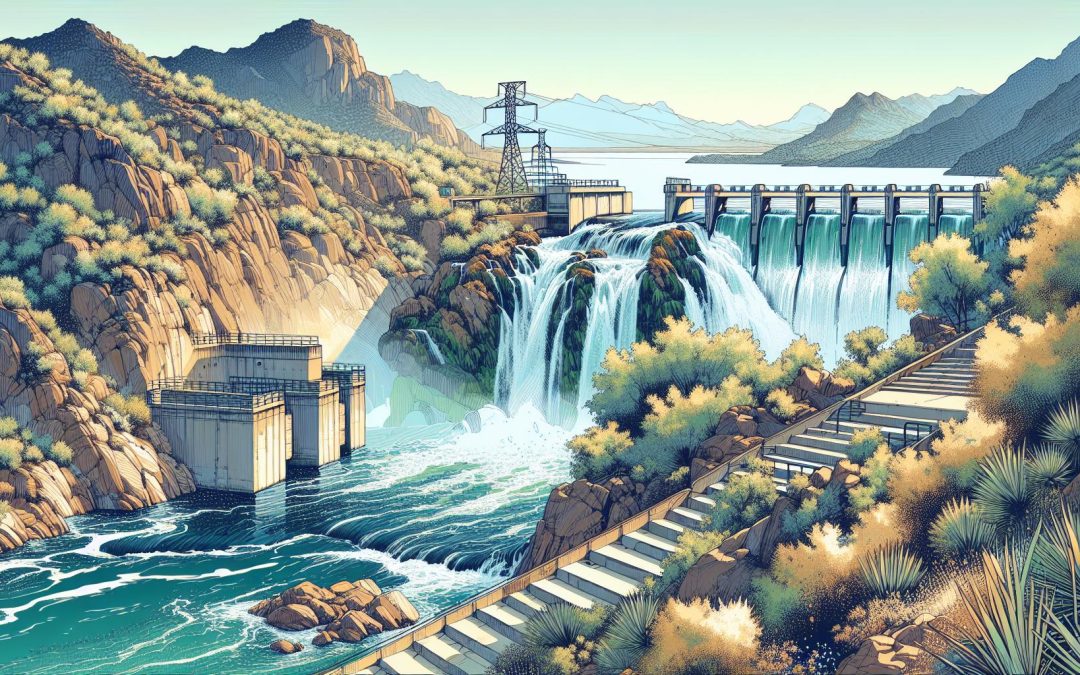Nestled in the heart of Phoenix, Arizona Falls isn’t just your ordinary urban oasis. It’s a place where natural beauty meets innovation, a waterfall powered by the very river it adorns. I’ve always been fascinated by how we can harness nature’s power in sustainable ways, and Arizona Falls is a prime example of this harmony.
This landmark isn’t just for show; it’s a fully operational hydroelectric plant that’s been lighting up lives since the early 1900s. Imagine walking through a serene park, the sound of water cascading down blending with the hum of clean energy production. It’s a reminder that even in the midst of urban sprawl, there’s room for environmental consciousness and historical preservation.
History of Arizona Falls
Nestled within the bustling streets of Phoenix, Arizona Falls isn’t just a marvel of nature; it’s a significant testament to the innovation and history of the area. I’ve always been fascinated by how places evolve over time, whether it’s through natural changes or human intervention. Arizona Falls is a prime example of both.
Originally, the Salt River Project used the natural 20-foot drop along the Arizona Canal for irrigation purposes in the late 1800s. It’s mind-boggling to think about how early settlers utilized the landscape to their advantage, harnessing the power of water long before modern technology.
By the early 1900s, the falls had been developed into a hydroelectric plant, which was quite revolutionary at the time. This early adoption of renewable energy sources highlights an environmental awareness that was far ahead of its time. The plant was capable of powering over 100 homes, a feat that might seem small by today’s standards but was monumental back then.
The site evolved into a public gathering place, with people flocking to the falls to escape the desert heat. The combination of refreshing water, the hum of the hydroelectric plant, and the community spirit turned Arizona Falls into a landmark. However, as the years passed, the area fell into disuse and was largely forgotten by the public.
It wasn’t until 2003 that the falls were revitalized in a collaboration between the Salt River Project, the City of Phoenix, and the Arcadia neighborhood. This renovation project aimed to preserve the historical significance of the site while reintroducing it as an urban oasis and educational hub. The designers used cutting-edge technology to restore the hydroelectric plant, ensuring that Arizona Falls could continue its legacy of sustainable energy production.
Design and Architecture

When I first caught glimpse of Arizona Falls, it wasn’t just the sound of water cascading down that caught my attention, but also the remarkable blend of form and function that defines its design and architecture. It’s a space where the industrial meets the natural, creating not just a utility, but a place for community and contemplation.
The architecture firm behind the restoration, ingeniously incorporated existing structures and water flow into a design that does more than generate power. They’ve made water the central actor in a beautifully arranged play of light, sound, and movement. Glass panels and viewing platforms allow visitors to observe the water’s journey and appreciate the engineering that harnesses its energy, turning the falls into a live exhibit on renewable energy.
The use of indigenous plants and materials in the surrounding landscape connects the site to its Arizona roots, grounding the high-tech facility in the natural world. Moreover, the integration of art installations throughout the site adds layers of meaning and engagement, making it a true urban oasis.
One standout feature is the waterfall itself, re-engineered to mirror the original natural falls that were once a gathering spot in the desert. It serves not only as a renewable energy source but also as a nod to the site’s historical significance. The sound of water falling, which can be heard even before the falls come into sight, instills a sense of anticipation and wonder, setting the stage for the experience ahead.
Walking through Arizona Falls, it’s impossible not to be impressed by how seamlessly function has been woven with aesthetics. The result is a space that educates, inspires, and provides a respite from the urban environment, all the while highlighting the importance of sustainable energy solutions in our modern world.
Hydroelectric Power Generation
When I first learned about Arizona Falls’ role in hydroelectric power generation, I was genuinely intrigued. Nestled within the city, this site isn’t just a scenic spot; it’s a powerhouse in its own right. Arizona Falls generates electricity by utilizing the natural flow of water, a clean and renewable energy source that’s both efficient and environmentally friendly.
Here’s a quick breakdown of how it works:
- Water from the Arizona Canal flows through the plant.
- The flow spins turbines, converting kinetic energy into mechanical.
- Generators then convert this mechanical energy into electricity.
The plant is surprisingly powerful for its size. It has the capacity to generate 750 kilowatts of electricity. To put that into perspective, here’s what this amount of energy can do:
| Capacity | Equivalent |
|---|---|
| 750 Kilowatts | Powering up to 200 average homes simultaneously |
This approach to generating power isn’t just about producing energy. It’s a brilliant example of how cities can harness natural resources in a sustainable way, without compromising the environment or the community’s aesthetic and recreational values. Arizona Falls not only contributes to the local power grid but also serves as a living classroom for renewable energy, educating visitors about the benefits of hydroelectric power.
The integration of this technology with public art and recreational space is what makes Arizona Falls stand out. It’s not often that one encounters an energy plant that invites public interaction and contemplation. The transparent design and informative displays allow me to see firsthand the process of generating electricity from water—a reminder of the potential that lies in combining technology with nature for the greater good.
Visitor Experience
As I stepped into the Arizona Falls, the ambiance shifted dramatically from the bustling urban life to a serene oasis, where the sound of falling water drowned out the city noise. The merge of nature with innovative engineering left me both intrigued and charmed. Designed not only as a hydroelectric plant but also as a public space, it offers visitors a unique blend of education and relaxation.
Walking through the facility, I couldn’t help but be amazed by the integration of art and technology. Large panels explain the process of generating hydroelectric power in a way that’s easy to digest, turning a complex subject into an interesting and accessible topic for people of all ages. The art installations surrounding the falls created an engaging backdrop, enhancing the educational aspect.
- Educational Exhibits: Detailed panels providing insights into the history, operation, and benefits of hydroelectric power.
- Art Installations: Contemporary works that blend seamlessly with the natural environment and the technology of the plant.
- Viewing Platforms: Strategically placed for vistas of the waterfall and the machinery, offering a firsthand look at hydroelectric power in action.
- Picnic Areas: Spaces to relax and soak in the surroundings, making it ideal for a family outing.
What stood out to me the most was the tranquility amidst the city. It’s a testament to the thoughtful design that balances the functional aspect of power generation with the aesthetic and recreational value. With each step, I found something new to appreciate – from the roar of the water to the subtle details in the art pieces. It’s clear that Arizona Falls isn’t just a place to learn about renewable energy but also a sanctuary in the heart of the city, where technology, art, and nature coexist beautifully.
Environmental Impact

When I first learned about Arizona Falls, I was curious about its environmental footprint. It’s impressive how this urban oasis manages to blend renewable energy production with minimal environmental disturbance. The hydroelectric plant harnesses the natural flow of water, a clean and sustainable energy source that helps reduce our reliance on fossil fuels. By generating power for up to 150 homes, the falls contribute significantly to the local grid with Zero Emissions.
The design also incorporates elements that support local wildlife and preserve the natural beauty of the area. The water, a precious resource in the arid climate of Arizona, is used efficiently. The circulation of water through the turbines and back into the canal system means there’s no wasteful consumption. This cycle supports the local ecosystem, providing a habitat for various species of birds and aquatic life that have made the falls their home.
Moreover, the surrounding landscape includes native plants that require minimal irrigation, further minimizing the water usage. These plants not only beautify the space but also play a crucial role in maintaining the local biodiversity. They attract pollinators like bees and butterflies, which are vital for the health of any natural environment.
It’s clear that Arizona Falls stands as a testament to what can be achieved when innovation is guided by environmental consciousness. The facility not only generates clean energy but also educates the public about the importance of sustainable practices. Through its integration of technology, art, and nature, it provides a powerful example of how urban infrastructure can contribute positively to the environment.
Conclusion
I’ve always believed that the places we live in can harmonize with nature and Arizona Falls is a prime example of this belief in action. It’s not just a place where water cascades beautifully but a beacon of how renewable energy can be seamlessly integrated into our urban landscapes. The fact that it powers homes while supporting local wildlife and promoting biodiversity is something that fills me with hope. It’s a reminder that innovation doesn’t have to come at the expense of our environment. Instead, places like Arizona Falls show us that with thoughtful design and a commitment to sustainability, we can create spaces that both serve our communities and preserve the natural world. It’s a lesson in the power of combining technology with environmental stewardship and one I’m thrilled to have shared with you.







